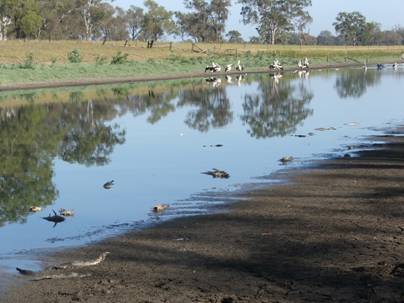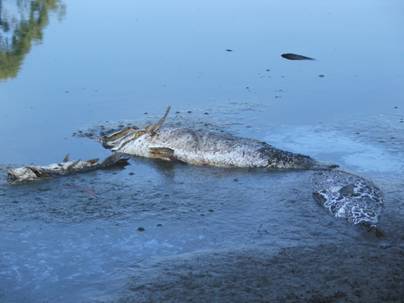What are animal kills?
A kill is an unexpected and generally short-lived event marked by the conspicuous death of large numbers of fish (e.g. fish kill) or other organism (e.g. usually birds). Animal kills in excess of one event per year are considered indicative of compromised ecosystem integrity according to criteria established during the National Land and Water Resources Audit.

Photo 1. Example of a fish kill in a coastal waterway (Copyright State of Queensland, Department of Primary Industries).
What causes animal kills?
- Globally, over half the fish kills result from natural causes (e.g. life cycle events, infectious diseases, bacteria and protozoa, decreasing water levels, reduced water quality, elevated water temperatures on foreshores, and changes in salinity caused by heavy rain).
- Fish kills often occur when dissolved oxygen concentrations drop to lethal levels during the decomposition of organic matter. When oxygen is depleted, anoxic & hypoxic conditions develop and anaerobic organisms take over the degradation of organic matter. Anaerobic respiration gives rise to hydrogen sulfide and ammonia gas which can also be toxic to fish and other organisms1. Degradation of algal biomass derived from algal blooms can cause water column oxygen to be consumed, and often results from excessive nutrient loads (e.g. eutrophication). Some point-sources of nutrients to coastal waterways are wastes from aquaculture operations, sewage discharged from yachts, boats & ships and coastal discharges such as outfalls from industry. The risk imposed by point-sources of nutrients in coastal waterways is higher in areas with large population densities or with significant tourism, and can be estimated by the number of point-sources per unit area of coastline. Nutrients loads diffuse sources (e.g. intensive agriculture in catchments and urban stormwater) are often larger and more difficult to control.
- Rainfall following the dry season in tropical regions can also mobilise organic-rich detritus (e.g. rotting weeds, grasses, cane trash and stormwater trash) into coastal waters and these can have a very high biochemical oxygen demand2. Links have also been found between the artificial opening of lagoons and fish kills, because shallow areas can be exposed to air causing the die-back of large amounts of filamentous algae3. Rainfall can also deliver nutrients to coastal wetlands, an input that can promote rapid growth of light-dependent benthic algae and phytoplankton assemblages4. When there is sufficient light for photosynthesis phytoplankton contribute to the amount of dissolved oxygen in the water column (oxygen is a by-product of photosynthesis)5, with peak oxygen production usually occurring during mid-afternoon6. However when there is not sufficient light for photosynthesis phytoplankton must use oxygen from the water to survive. Consequently demand for dissolved oxygen increases towards nightfall and continues throughout the night. Lowest dissolved oxygen concentrations in the water column occur around dawn7. In some instances that demand can push oxygen levels below critical survival levels for fish and other anaerobic organisms4. In other instances the increased turnover of phytoplankton contributes to detrital input and increased biochemical oxygen demand.
- A lack of rainfall may also initiate fish kills (Photos 2ab). There are two ways that the drying of wetlands (e.g. during drought periods) impacts on fish faunas. The most obvious is that water volumes reach a critically low level and can no longer support the oxygen demands of fish assemblages. Additionally, as water volume decreases the oxygen carrying capacity of water is reduced because of higher water temperatures89 and higher salinity levels. Secondly, as water becomes shallower fish are more easily accessed by surface feeding birds such as pelicans 1011. This means that biomass accumulated in wetlands is transported to other habitats as the pelicans move about and in some cases results in an almost complete removal of fish before fish kills occur 12. It is worth mentioning that the projected changes in temperature and rainfall in Australia (2030-2070) due to global warming suggest a general drying trend for much of the continent.


Photo 2 (a and b): Fish kill at Woolwash Lagoon, Rockhampton, in September 2005. This kill is a result of drying out of the lagoon during drought. Prior to drying this lagoon held very high densities of fish, but by this stage of drying (max depth 40 cm) there are few fish left. Most had been consumed by pelicans. Most of the fish that remained were too large for the pelicans to handle such as the barramundi and catfish in 2b. (photo’s courtesy of Ross Johnston, James Cook University)
- Inappropriate use of pesticides may also lead to local fish kills. Examples include endosulfan runoff from agricultural areas when this chemical is applied before rainfall13 and drift from chemicals used to control mosquitoes and other biting insects in intertidal wetlands. Birds are also sensitive to the long-term effects of toxicants (e.g. herbicides, pesticides and heavy metals) due to their high metabolic rate. Impacts may be acute and result in death or be chronic, leading to reduced reproductive capacity. The industrial point source hazard and stormwater discharges indicators can be used to assess toxicant risk from urban and industrial sources. The pesticide hazard indicator can be used to assess toxicant risk from agricultural sources.
- Runoff from acid sulfate soils (ASS) can cause fish kills14. The fish die from the metabolic impacts of low pH itself, or from the toxicity of heavy metals mobilised with the drainage. This may result from natural processes but in many cases, drainage of wetlands (e.g. mangroves and salt marshes) leads to increased oxidation of ASS and potential acid sulphate soils (PSS), with pH levels becoming extremely low. Coastal waterways with rivers in acid hazard zones are most at risk for acid sulfate drainage.
- Outbreaks of harmful algae (e.g. Pfiesteria) produce a variety of biotoxins that kill fish and birds15. Birds and fish that feed on filter-feeding molluscs may be particularly susceptible because such organisms concentrate contaminants.
- Accidental and illegal dumping of oil, discarded trash (e.g. plastic rings, cigarette lighters) and entanglement in fishing lines are widely publicised causes of bird kills. Risks imposed by fishing may be assessed using the fishing pressure indicator. Risks imposed by marine trash and oil can be assessed using the shipping, boating and yachting and stormwater discharge indicators.
Environmental significance
Fish kills can deplete valuable stocks and render others susceptible to overfishing. Animal kills can also disrupt food web dynamics and the interdependencies between species. They can promote colonisation by noxious species and eliminate species essential to the healthy functioning of communities. Kills are also aesthetically unpleasant because they litter coastal waters with rotten smelly carcasses. The effects of a fish kill may extend further if birds and other predators consume contaminated fish.
Considerations for measurement and interpretation
Animal kills should be reported immediately to either the Environment Protection Agency (EPA), local government, or the Department of Primary Industries. EPA, as lead agency, has a reporting protocol to allow for early response. Kills should be reported in terms of the numbers, species, weight and size distributions. Dead and dying fish/birds as well as samples of sediment and water from the kill site should also be collected as soon as possible after the kill. Other factual information pertaining to the kill site should accompany the samples (e.g. industrial or agricultural activity in the vicinity of the kill, the presence of abnormal materials or unusual colourations in the water or presence of recently dumped rubbish). However, because of the nature of fish kills, dead fish/birds may not be apparent for several days after the impact of the chemical or other factor that caused the mortality. Where disease is expected, animals should be submitted to designated authorities for diagnosis. Monetary and economic valuation of fish kills should be undertaken whenever possible16.
Existing information and data
Government institutions and state agencies keep records of reported fish and bird kills. The NLWRA compiled information on fish kills for a large number of Australian coastal waterways. These data are available in the OzEstuaries database. EPA offices have manuals that explain how to respond to fish kills. Early response is vital if the cause is to be identified and those responsible are to be located. The Fisheries Act1 994 has provisions that can order the restoration of fish stocks or fish habitats following a fish kill. The American Fisheries Association has produced a book detailing procedures for the assessment and valuation of fish kills16.
More information on biota removal/disturbance.
Contributors
John Beumer, Queensland Department of Primary Industries
Ross Johnston, James Cook University
- Connell, D.W., Miller, G.J. 1984. Chemistry and Ecotoxicology of Pollution. John Wiley & Sons, N.Y. ↩
- Veitch, V. Fish Kills, Sunfish Queensland. ↩
- Wilson, J., Evans, P., and Kelleher, N. 2002. Fish kills in Cockrone Lagoon – Implications for entrance opening of coastal lakes. Proceedings of Coast to Coast 2002 – “Source to Sea”, Tweed Heads, pp. 101-104 ↩
- Johnston, R., Sheaves, M. (2006). An analysis of fish kills in Curralea Lake during 2005. Report prepared for Townsville City Council, June 2006. ↩ ↩
- Raven, PH., Evert, RF., Eichhorn, SE. (1992) Biology of plants. Worth Publishers, New York. ↩
- Newton, A., Mudge, SM. (2005) Lagoon-sea exchanges, nutrient dynamics and water quality management of the Ria Formosa (Portugal). Estuarine, Coastal and Shelf Science 62(3):405-414.
- ↩
- Newton, A., Mudge, SM. (2005) Lagoon-sea exchanges, nutrient dynamics and water quality management of the Ria Formosa (Portugal). Estuarine, Coastal and Shelf Science 62(3):405-414. ↩
- Whitfield, AK. (1995) Mass mortalities of fish in South African estuaries. Southern African journal of aquatic sciences. 21:1-2. ↩
- Watts, J M., Swan, BK., Tiffany, MA., Hurlbert, SH. (2001) Thermal, mixing, and oxygen regimes of the Salton Sea, California, 1997-1999. Hydrobiologia 466: 1-3. ↩
- Derby, CE., Lovvorn, JR. (1997) Predation on fish by cormorants and pelicans in a cold water river: a field and modelling study. Canadian Journal of Fisheries and Aquatic Sciences 54:1480-1493. ↩
- Kaeding, LR., (2002) Factors influencing the distribution of American white pelicans foraging on the Yellowstone River, Yellowstone National Park, USA. Waterbirds, 25:305-311. ↩
- Sheaves, M., Collins, J., Houston, W., Dale, P., Revill, A., Johnston, R., Abrantes, K. (in press) Contribution of Floodplain Wetland Pools to the Ecological Functioning of the Fitzroy River Estuary. Cooperative Research Centre for Coastal Zone, Estuary and Waterway Management, Brisbane. ↩
- Napier, G M, Fairweather, P G and Scott, A C. 1998. Records of fish kills in inland waters of NSW & Queensland in relation to cotton pesticides. Wetlands [Australia] 17[2]:60-71. ↩
- see National strategy for the management of coastal acid sulfate soils – 2000. ↩
- see CSIRO Marine Research, Media and Information fact sheets. ↩
- see The American Fisheries Society. ↩ ↩


